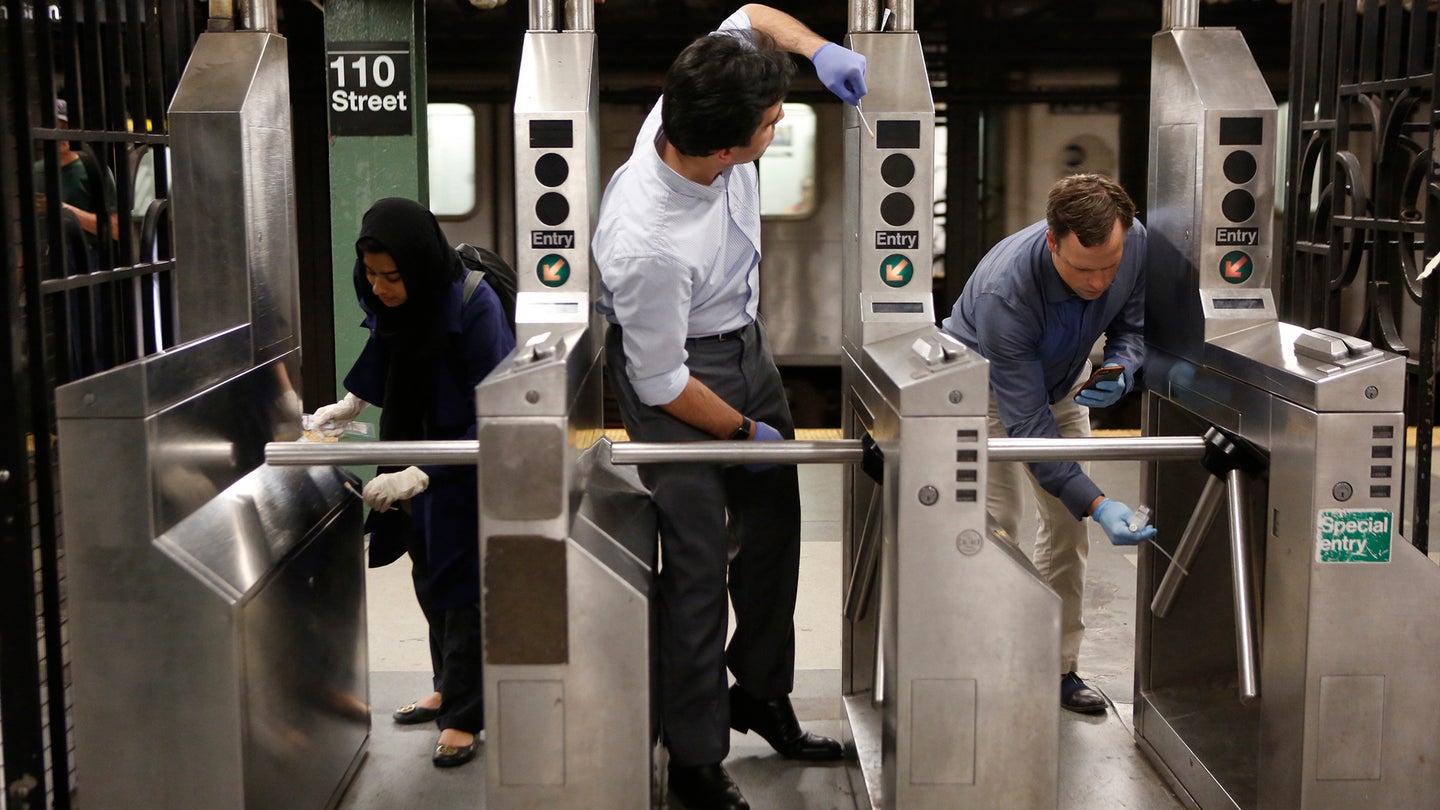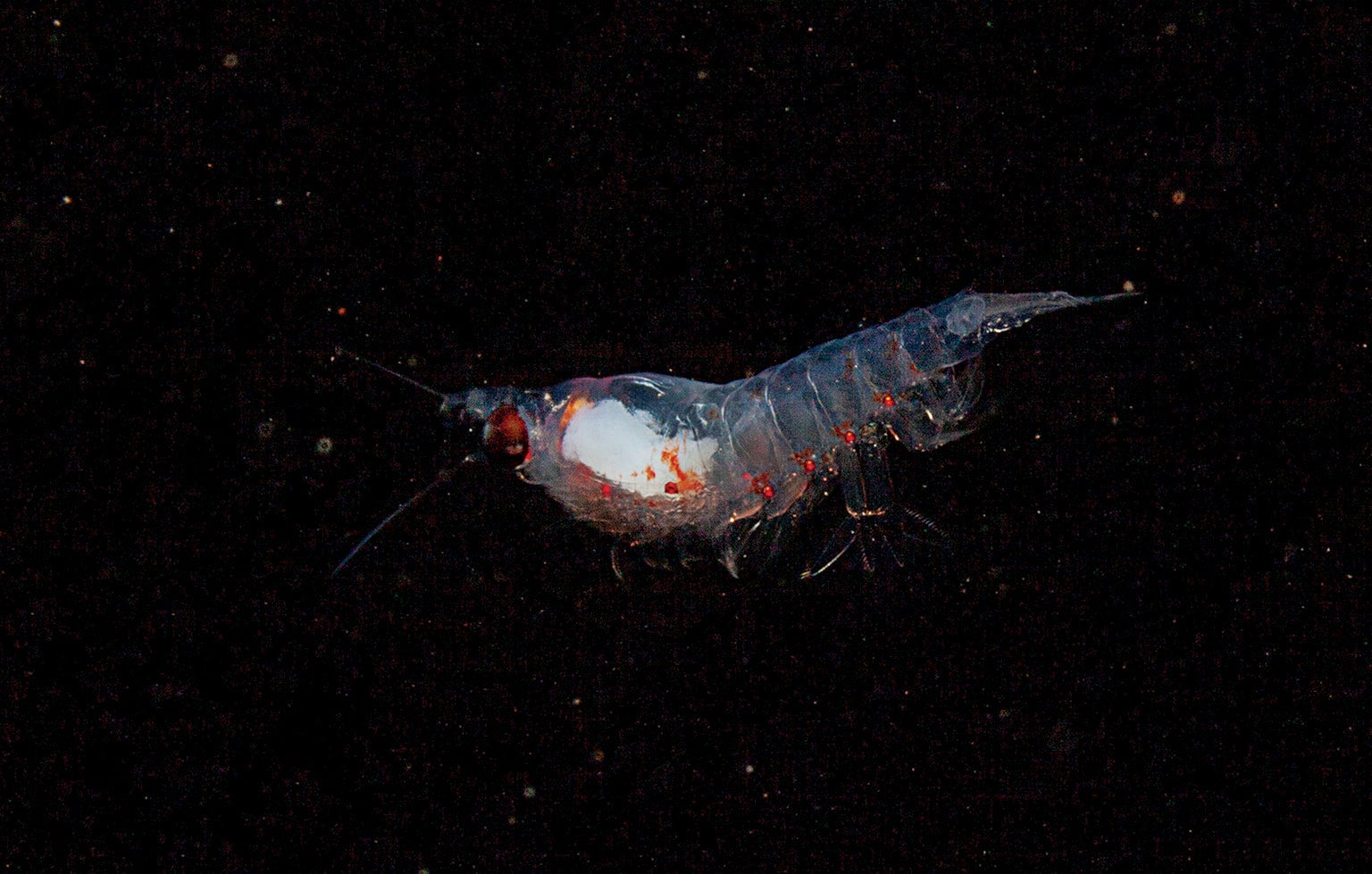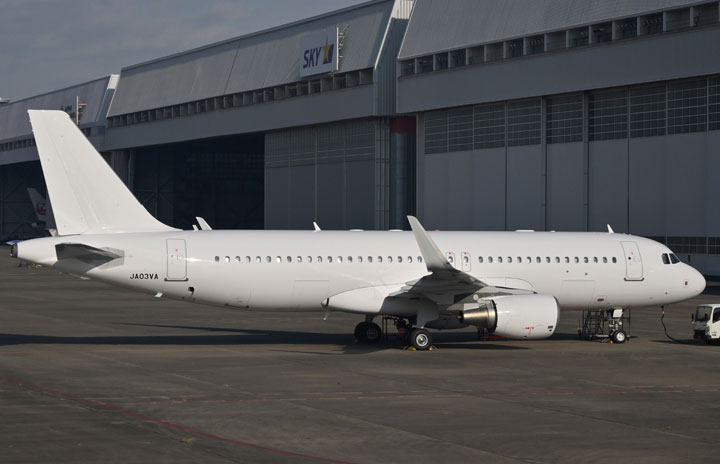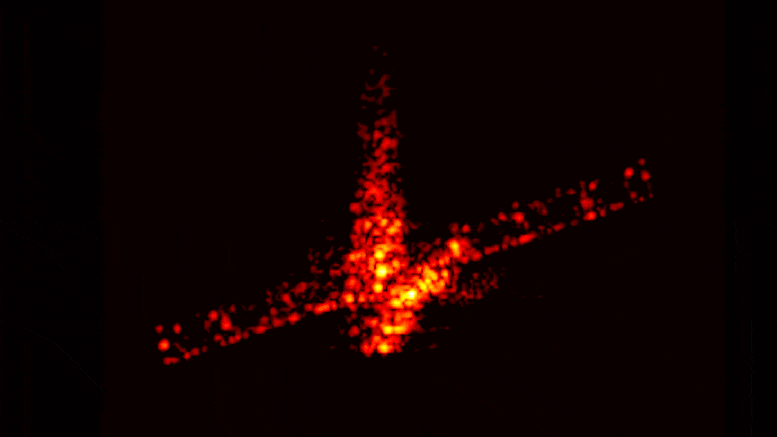In their quest to detect early outbreaks, virus hunters are sampling environmental DNA in water, dirt, and air.
Rene Ebersole / Undark
|
Published Feb 19, 2024 8:00 AM EST

This article was originally featured on Undark.
It all started when Christopher Mason’s 3-year-old daughter licked a subway pole.
Like any parent, he was horrified, but also keenly curious: What types of microbes might be clinging to a metal pipe gripped by countless commuters every day?
Mason, a geneticist at Weill Cornell Medicine, soon became obsessed with that question. His toddler’s gross interlude inspired him to embark on a journey to unveil the world of bacteria, fungi, and viruses co-mingling with more than 8 million people in New York City’s urban jungle.
In 2013, he launched a project that began dispatching a small army of students shouldering backpacks crammed with latex gloves, vials, and sterile Q-tips. They sampled turnstiles, benches, and kiosks at every open metro stop in the city. It was an expedition into a largely unexplored terrain, like Mars or a deep-sea canyon, brimming with lifeforms both familiar and unknown.
The swabbers were sampling what’s called environmental DNA, or eDNA, representing the assortment of cells that all humans, animals, and microorganisms naturally shed as they go about their everyday lives, leaving genetic fingerprints. The scientists gradually quantified and mapped the unseen biological diversity—the microbiome—of the entire city. In 2015, they reported that they’d found more than 1,600 different types of microbes, nearly half of which were previously known to science. Most were harmless, associated with human skin and gastrointestinal tracts. About 12 percent were known pathogens, including fragments of genomes similar to Bubonic plague and anthrax, though there was no evidence that these small bits could make anyone sick. They hadn’t found any new deadly viruses lurking in New York’s underground—yet.
Four years later, in late 2019, Mason and his colleagues started hearing about a mysterious pneumonia-like disease circulating in China. “We weren’t immediately worried,” he said, “but by January it was clear that it had jumped across the ocean and was spreading.” Suddenly the subway swabbers became front-line workers monitoring Covid-19’s presence, not only in transit systems, but also in hospitals, and wastewater. “We had a new medical focus,” Mason said, “with protocols and tools that could be deployed anywhere.”
Today Covid-19 has killed nearly 80,000 New Yorkers, almost 1.2 million Americans, and nearly 7 million people worldwide. The pandemic catalyzed a push for new technologies that allow scientists to quickly characterize organisms leaving a genetic trace in the environment. Similar to how city-leveling hurricanes have fueled innovations in weather surveillance and building engineering, the pandemic has helped propel the science of pathogen hunting.
The field of eDNA research has mushroomed in the last 15 years as sequencing, computing technology, and metagenomics—the study of DNA from multiple organisms—has advanced. Now, scientists around the world can sample from a cup of dirt, a vial of water, or even a puff of air, and survey the eDNA present for thousands of microbial species. And while the field at-large has faced concerns about privacy and technical limitations, many scientists see an opportunity to further early detection of emerging pathogens. Wastewater surveillance is the most advanced method for monitoring population-level virus spikes, but other realms are catching up. As a result, health officials are becoming better prepared to detect an outbreak—and quickly take steps to contain it.
Experts say the technology may soon become so advanced that an environmental sample, such as air filtered from a high-risk area—a wet market, a hospital, a conference hotel—could be automatically sequenced in a portable device that will report if a threatening pathogen is present. Researchers are using genomic databases to aid rapid identification of pathogens and other microbes. Scientists are getting close to “being able to monitor these high-risk interfaces in real time,” said Erik Karlsson, a virologist at Institut Pasteur du Cambodge, a nonprofit research institution in Cambodia.
“We like to say, we’re trying to get left of sneeze.”
The ultimate goal in virus hunting is an early warning system: to find a pathogen that could spark a disease outbreak before it has the chance to do so. The key, say scientists, is monitoring high-risk areas where animals and people intermingle. Those places are usually on the boundaries between areas where humans live and tropical forests, where people hunt and capture animals for food, pets, and ingredients in medicine, or in markets where animals are slaughtered for consumption.
“We like to say, we’re trying to get left of sneeze,” said Karlsson, who monitors for avian influenza and other pathogens in Cambodia’s live bird markets. That means they’re trying to identify potentially threatening pathogens before they spill over into humans, or before they jump into a different animal type and causes an outbreak. “We want to be able to get ahead of that,” he said.
Studies show more than 70 percent of the infectious diseases that have emerged in the 21st century—including Ebola, HIV, and mpox (formerly monkeypox)—leapt to humans from wildlife. What’s more, there has been a significant increase in zoonotic disease hopping from wildlife to humans over the past 80 years. These events are commonly known as “spillovers.”
Research shows there is one main phenomenon, often in a remote faraway place, that precedes a spillover: a forest clearing.
As forests are felled for timber, farming, and human development, people living and working in the adjacent areas hunt and scavenge for animals to be used for food, or sold—at times illegally—as pets or made into medicinal products. Those who handle the animals can become exposed to new pathogens. Whether or not one of those pathogens makes the leap to a person and triggers an outbreak depends on a variety of factors, including how the virus evolves and human immunity.
Forested areas in Africa and Southeast Asia, where vast tracts of previously pristine wilderness are being logged, are among the leading hotspots for emerging animal-borne, or zoonotic, disease. In Africa, there has been a 63 percent rise in the number of zoonotic outbreaks in the last decade, according to the World Health Organization. Those outbreaks include Ebola, viral hemorrhagic fevers, dengue, anthrax, plague, and mpox.
Ebola is one of the most famous and feared among the group. First discovered in 1976, the virus kills by storming the immune system, causing it to go into hyperdrive, damaging blood vessel walls so severely the arteries, veins, and capillaries start to leak blood, causing medical shock and organ failure.
The most widespread Ebola outbreak began in December 2013, when a virus living in a bat somehow spilled over to a 18-month-old boy named Emile Ouamouno in southern Guinea. Ouamouno—“patient zero”—was suffering from a fever, passing stool blackened with blood, and vomiting. He died within days, and was quickly followed by his mother, young sister, and grandmother.
Soon the disease appeared in nearby Guéckédou, a city of nearly 350,000, alerting world health officials to an Ebola outbreak. Ultimately the outbreak spread to Sierra Leone, Liberia, Nigeria, and six other countries, including the United States, with three cases in Dallas, Texas. By the time the epidemic ended in 2016, it had killed more than 11,300 people and infected 28,600.
Eeva Kuisma is a veterinary scientist working for the Wildlife Conservation Society, a global nonprofit conservation group. In the Republic of Congo, she is working to expand a project that could become the first long-term surveillance program for Ebola and other diseases based on forest environmental DNA sampling. The research builds on an ongoing public education and disease surveillance program in which researchers visit rural communities to provide information about the dangers of Ebola virus and other animal-borne diseases, and how to minimize the risk of exposure. Hunters and foragers are encouraged to report sightings of animal carcasses in the forest to a hotline. So far, the program has engaged 5,800 hunters in more than 290 villages.
As part of the new study Kuisma is launching, survey teams will spend 12 months every five years walking systematic transects across more than 8 million acres of forest. Along their path, they’ll swab eDNA samples from animal carcasses and feces.
Representing a wide range of animals, from gorillas and chimpanzees to river hogs and antelopes, the samples are being tested for Ebola and other pathogens. Kuisma and her colleagues are using the latest advancements in DNA analysis to compare the genetic material against a database of DNA sequences, revealing the identity of many microorganisms present, from bacteria to pathogens and viruses.
Kuisma said long-term data from the project could become valuable for monitoring the appearance of Ebola or any other pathogens against the backdrop of big landscape changes. One example is a proposed $1.7 billion road project connecting Congo, Chad, and the Central African Republic, “areas which have been really pristine rainforest up until now,” she said.
It’s early days for the research, but ongoing environmental sampling for Ebola virus might one day short circuit a spillover and save lives. “If we have indications, for example from the feces or from carcasses, that there is an active epidemic in the animal population,” Kuisma said, “we can inform people, to warn them that this is happening and to educate them to not go and eat carcasses, not to pick them up, not to touch them.”
Over the last century, Southeast Asia has been another major hotspot for emerging zoonotic diseases, but recently, the risk of a spillover has picked up. Population growth, deforestation, climate change, and the expansion of poultry and pig farming have all led to the emergence of a long list of diseases, including Middle East Respiratory Syndrome, Zika virus, and Highly Pathogenic Avian Influenza, or HPAI.
Karlsson, the virologist in Cambodia, helps oversee researchers in Phnom Penh collecting environmental samples in areas where people and animals intermingle. Whereas previously, researchers would have to hand collect feces, blood, urine, and other biological samples, recent developments in rapid genetic sequencing have made it easier for them to do their work more quickly and safely. “Environmental samples are really, really good for speed,” Karlsson said. “We don’t have to capture animals. We don’t have to get the same kinds of permits. You don’t have to have people that are trained to handle potentially dangerous animals like bats and things like that. You can go out in the environment, get these samples very quickly.”
Recently, a new tool for hunting viruses has become more widely available: air sampling. Karlsson’s team is using air filters designed for construction workers to wear on the job, or to purify the air in hotel lobbies to sample public markets where vendors slaughter, clean, and defeather chickens—high risk areas for an avian influenza outbreak.
In a study published in March 2023, the researchers recruited vendors scattered throughout a market to wear personal air samplers 30 minutes a day for a week while going about their business during periods when the circulation of avian influenza in poultry is predictably high in February and low in May. In February, they found viral RNA in 100 percent of air samples. They could also see the virus decreasing as they got farther from the chicken slaughter area, confirming that slaughter areas are potentially the “most high-risk area of the market,” Karlsson said, and illustrating the need for interventions such as improved ventilation.
Karlsson’s team is now using hand-held air-filtering devices no bigger than a credit card reader to sample for viruses in places that are both challenging and sometimes dangerous for researchers to go swabbing, such as bat caves. Bats are reservoirs for a wide variety of viruses that infect people—including Covid-19. They’re pairing the small samplers with toy drones and remote-control cars that can easily access a cave while the scientists wait outside.
Karlsson often thinks about other types of technology that could be deployed for passive, remote sampling — and one day a comprehensive machine that could not only collect a sample, but also process it on the spot. “Can we hook it up to a Roombaa, or something like that, constantly cleaning the floors and then sucking in the sample,” he said. “You see there’s a lot of options.”
Peter Thielen is a molecular biologist at Johns Hopkins Applied Physics Laboratory, where he leads viral genomic surveillance projects, including in collaboration with Karlsson. He said Karlsson has been uniquely positioned in a high-risk area for disease spillover to pilot some of the latest technologies to improve response time to outbreaks. “This ability to take the lab to the sample is exactly what’s needed,” he said.
While some scientists are working to detect pathogens floating in the air, the Covid-19 pandemic really opened the floodgates to the concept of hunting for viruses in wastewater. Since people shed genetic material from the virus in their feces and urine, wastewater surveillance became one of the best way to track disease spikes, including which city apartment building and what university dormitory contained people with Covid-19—even before they became symptomatic.
It wasn’t a novel concept. Wastewater surveillance dates all the way back to the mid-1800s, when John Snow, a British physician, was investigating a mysterious cholera outbreak in London. Citizens called it the “blue death,” because the dehydration caused by intense diarrhea and vomiting led to sunken eyes, shriveled skin and a bluish-gray pallor that made patients look like living corpses. Many believed a “miasma,” an evil cloud of poisonous air, was to blame.
“We don’t have to capture animals. We don’t have to get the same kinds of permits. You don’t have to have people that are trained to handle potentially dangerous animals like bats.”
Snow, however, had a hunch that cholera was waterborne. He painstakingly mapped the cases and finally traced their origin to a contaminated water pump on Broad Street in London’s West End. When he convinced the local council to remove the pump’s handle, the outbreak ceased. Today Snow is celebrated as the father of modern-day epidemiology.
During the last century, wastewater has become an important tool for monitoring community health, particularly for tracking drug use trends in cities and finding—and quickly eliminating—polio outbreaks. Still, wastewater was on the margins of widespread use in the U.S. a decade ago, when a scientist with the Environmental Protection Agency proposed a nationwide system to monitor community health. He couldn’t get anyone to back the idea then.
In September 2020, the Centers for Disease Control and Prevention finally launched the country’s first National Wastewater Surveillance System, which collects and tests samples as wastewater flows into treatment plants, and reports those results to the CDC to help guide local response. By then, though, more than 200,000 Americans had died from Covid-19. If the surveillance system had been up and running when the virus first came ashore in the U.S., it might have been detected much sooner, said Mason, the geneticist at Weill Cornell Medicine. “We would have known immediately within a day or two where the virus was appearing.”
Wastewater continues to provide important intel about where the virus is circulating and the public’s risk of exposure, particularly as clinical testing has been replaced by readily available home test kits. It’s also helping health officials track the arrival and spread of new Covid-19 variants as they’re emerging.
“We’re out of the pandemic officially, but we still have circulating viruses, so what’s interesting is we can see them in the wastewater,” Mason said. If the abundance of the virus spikes, as it did recently in early September 2023—nearing the same levels as in late 2020—health officials can warn the public to take precautions to minimize exposure, such as mask wearing, hand washing, and social distancing. “It’s good that most people have either been vaccinated or already infected, or both,” Mason added.
Resources spent on developing the infrastructure for pathogen surveillance in wastewater has put the country in a better position to identify and respond to other health threats, including antibiotic resistance, foodborne diseases, mpox, and respiratory syncytial virus (RSV), experts say, but the program is still young, and there are some ethical and privacy concerns too.
It’s a lot cheaper and more time-efficient to test sewage than to swab hundreds of people, or do blood testing, but wastewater is largely unregulated for privacy. What kinds of rights people have over what they flush and what’s done with it is extremely murky. The National Academies of Sciences recently published a report detailing the ways in which the national wastewater surveillance system needs to implement sufficient oversight to protect privacy rights while further developing to monitor more communities, track multiple pathogens at the same time, and pivot to deal with emerging threats when a pathogen spikes.
“I like to joke, and say every time that a toilet flushes and if nobody takes a sample, somewhere an epidemiologist is crying,” Mason said, laughing. “The amount of information that’s present in every bit of wastewater is extraordinary. I think we’re just beginning to tap it.”
Mason’s work mapping New York City’s microbiome prompted researchers around the globe to contact him to discuss plans to swab their cities too. As interest grew, Mason and Evan Afshin, a medical student at New York Medical College, founded a global organization comprised of scientists from more than a hundred cities, known as Metagenomics and Metadesign of Subways and Urban Biomes, or MetaSUB consortium, rubbing Q-tips on surfaces in their countries’ transit systems, sewage canals, hospitals, and other public places.
Similar to how naturalists have assembled volumes representing all the birds in North America, or all the fish in the Pacific, Mason and his colleagues have created an atlas of microorganisms found in urban mass transit systems around the globe. The scientists are now using sequencing technology and AI-powered software to develop a worldwide reference library of microbes and an open-sourced platform that allows users to enter a pathogen DNA sequence and see where else it has appeared in the world. “We want to make it so anybody anywhere can upload their sequence, and compare it to anything else that’s ever been sequenced,” Mason said.
In late October, GeoSeeq Foundation, a nonprofit data platform associated with a health-tech company Mason co-founded, announced it was teaming up with the Pasteur Network, an organization with an international network of scientists. The collaboration’s aim is to closely examine rising infectious disease driven by climate change, including mosquito-borne illnesses like malaria and dengue. An Oct. 31 press release said the partnership could “usher in a new era of global pathogen surveillance and response.” It combines the Pasteur Network’s reach—32 institutes spread across 25 countries on 5 continents—with GeoSeeq’s AI platform pulling from a wide variety of data streams, including climate, genomics, and public health.
“This connects all the labs around the world to be able to see if any new virus is emerging,” Mason said in an email. “We can keep people safe once we know where the risks are, and we also can discover entirely new kinds of creatures in the world!” By identifying all types of microbes, researchers might also discover new antibiotics, and they’re gaining the ability to track and map antibiotic resistance. Whether such an early warning system will catch a future pandemic pathogen remains to be seen.
Still, many pathogen trackers say the big dream is to one day have a worldwide disease surveillance system on par with current weather forecasting. Information about such factors as air pressure, temperature, and wind currents feed into weather maps that help forecasters identify developing storm patterns and aid response plans. The same can be done with microbial data feeding a global disease surveillance system, a costly endeavor, but worth it, Mason said, because “money spent on pathogen surveillance is much cheaper than a shutdown of the entire economy.”
Scientists have learned a lot of lessons during the Covid-19 pandemic, he said. Now they just need to apply them.
Note: This article have been indexed to our site. We do not claim legitimacy, ownership or copyright of any of the content above. To see the article at original source Click Here












